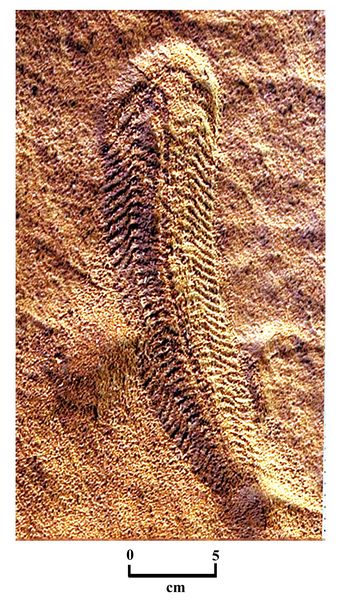Athena Review Image Archive ™
Spriggina floudersi from Ediacara, Australia

Spriggina floudersi from Ediacara, Australia (after Wade 1968 ).
Spriggina floudersi was a multi-celled marine organism dating from the end of the Late Precambrian period at 600-542 mya. It is named Spriggina for Reginald Spriggs, who discovered the fossil site in 1946 in a sandstone formation in Flinders Mountain Range, at Ediacara in south Australia. This site is the name source of the Ediacaran stage of the Late Precambrian, defined by various macroscopic marine organisms, the earliest yet known in the history of life on Earth.
Further samples of Spriggina were recovered by Glaessner and Daly (1958). Spriggina belongs to the superphylum Bilateria, the phylum Proarticulata, and the family Sprigginidae.
S. floundersi
had a segmented body of 3-5 cm length, and may have been
predatory. Its bottom is covered with two rows of tough interlocking
plates, while one row covered its top or dorsal surface. Its first two
front segments fused to form a head. The front segment was the
shape of a horseshoe, with a pair of depressions on its upper surface
which may represent eyes. The second segment may have borne
antennae. Subsequent segments bore ring-like forms or annulations. Like many of the Ediacara biota, the relationship of Spriggina to other groups is unclear. It bears some similarity to the living polychaete worm Tomopteris.
References:
Glaessner, M.F. and B. Daly 1959.Geology and Late Cambrian Fauna of the Ediacara Fossil Reserve. Rec.S.Austral.Mus.13.
Spriggs, R.J. 1947. Early Cambrian (?) Jellyfishes from the Flinders Ranges; South Australia. Trans.Royal Soc.S.Austral.71; pp.212-224.
Wade, M.J. 1968. Preservation of soft-bodied animals in Precambrian sandstones at
Ediacara in South Australia. Letheia 1; pp. 238-267.
Copyright © 1996-2020 Rust Family Foundation (All Rights Reserved).